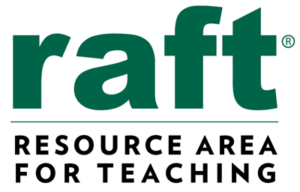As the End of School Approaches, What’s Keeping You Afloat?
Do you ever get that sinking feeling that you have so much yet to do with your class, but you are running out of time? Feel like you are about to hit an iceberg around the corner with the end of school activities approaching? Can you survive without a life jacket?
Believe it or not, the 106th anniversary this year of the sinking of the Titanic on April 15th got me thinking about how it might feel to be a stressed-out teacher at this time of year!
It occurred to me: you don’t have to crash and fall apart! Just like a raft carrying you home to safety (here goes another analogy), let the Resource Area For Teaching (RAFT) help you with a shipload of supportive ideas to point you back on course!
Ahem… Ok, I know, I know… enough already with the Titanic puns…. But, really, when you think about all the testing, lessons, assessments, end of school plans, and so forth, it can sometimes feel like time’s shrinking faster than ever, leaving you little to offer besides prescribed lessons and standardized testing! So, how do you keep creating and what can you do to keep your students engaged and interested in learning?
Think about what makes you interested in learning. Do you ever take creative risks in making subjects come alive for your students? Even what seems like a little thing, like talking with your students about when you have “failed” at learning something, and only after trying again and again until you made eventual progress did you really “grasp” a concept.
Hands-on student-driven STEAM design challenges can seem risky to try with your students at the end of the school year, especially if you haven’t used them yet. However, students who are engaged in their own self-directed approaches to solving problems that they identify with are more likely to retain and to understand the reasons for learning STEAM subjects.
Take this time as a chance to engage students in creative thinking and exploration. For instance, instead of asking students to write a report about world hunger, have your students decide how they want to investigate the topic. Maybe they’d want to film documentaries, record podcasts, or write blog posts. These creative risks often lead to small innovations that move on to more significant discoveries. Student blogging leads to kids actually enjoying writing and telling stories they care about. Students can create their own books and articles, which you can add to a digital journal for the school. A simple service project could turn into something that changes the world!
You don’t have to make this a massive change. Even if taking a small risk isn’t a big deal to you, believe me, it is a big deal to your students. They will remember what they have learned, and you become the teacher they never forget.
RAFT offers over 750 Idea Sheets, ready to download for free on its website. Each provides hands-on investigations to exploration aligned with standards by grade level(s) that can be extended as part of a design challenge scenario.
RAFT also offers Makerspace Design Challenges by grade level that encourage student voice and choice and that your students will find intriguing, creative, and relevant.
Think about what you need to cover, and assess what you want your students to learn. Then search the RAFT Idea Sheets and Design Challenges (including student journal pages, sample dialogs, background information, assessment material, and more) that help you make the best out of the remaining months of school. Your students will gain relevant knowledge and skills in the process, and you will avoid unnecessary risks of panicking over how to cover remaining topics while keeping students engaged and self-innovated.
Here are a few Idea Sheets and Design Challenges to consider (ok, ok… you could relate them to the Titanic).
Idea Sheets:
Design Challenges:
- 1st grade: Design a Morse Code
- 3rd grade: Safe Crossings
- 7th grade: Early Warning Systems


